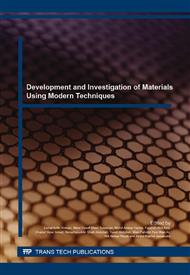[1]
S.J. George, Cutting Tools Application, ASM International, (2002).
Google Scholar
[2]
Z. Liu, X. Ai, H. Zhang, Z. Wang, Y. Wan, Wear patterns and mechanisms of cutting tools in high-speed face milling, J. Mater. Process. Technol. 129 (2002) 222–226.
DOI: 10.1016/s0924-0136(02)00605-2
Google Scholar
[3]
K. Aslantas, İ. Ucun, a. Çicek, Tool life and wear mechanism of coated and uncoated Al2O3/TiCN mixed ceramic tools in turning hardened alloy steel, Wear. 274-275 (2012) 442–451.
DOI: 10.1016/j.wear.2011.11.010
Google Scholar
[4]
N.A. Rejab, A.Z.A. Azhar, M.M. Ratnam, Z.A. Ahmad, The effects of CeO2 addition on the physical, microstructural and mechanical properties of yttria stabilized zirconia toughened alumina (ZTA), Int. J. Refract. Met. Hard Mater. 36 (2013) 162–166.
DOI: 10.1016/j.ijrmhm.2012.08.010
Google Scholar
[5]
A.Z.A. Azhar, H. Mohamad, M.M. Ratnam, Z.A. Ahmad, Effect of MgO particle size on the microstructure, mechanical properties and wear performance of ZTA–MgO ceramic cutting inserts, Int. J. Refract. Met. Hard Mater. 29 (2011) 456–461.
DOI: 10.1016/j.ijrmhm.2011.02.002
Google Scholar
[6]
A. Senthil Kumar, a. Raja Durai, T. Sornakumar, Development of yttria and ceria toughened alumina composite for cutting tool application, Int. J. Refract. Met. Hard Mater. 25 (2007) 214–219.
DOI: 10.1016/j.ijrmhm.2006.05.002
Google Scholar
[7]
a. Senthil Kumar, a. Raja Durai, T. Sornakumar, Development of alumina–ceria ceramic composite cutting tool, Int. J. Refract. Met. Hard Mater. 22 (2004) 17–20.
DOI: 10.1016/j.ijrmhm.2003.10.005
Google Scholar
[8]
N.A. Rejab, A.Z.A. Azhar, K.S. Kian, M.M. Ratnam, Z.A. Ahmad, Effects of MgO addition on the phase, mechanical properties, and microstructure of zirconia-toughened alumina added with CeO2 (ZTA-CeO2) ceramic composite, Mater. Sci. Eng. A. 595 (2014).
DOI: 10.1016/j.msea.2013.11.091
Google Scholar
[9]
C. Xu, X. Ai, C. Huang, Fabrication and performance of an advanced ceramic tool material, Wear. 249 (2001) 503–508.
DOI: 10.1016/s0043-1648(01)00581-6
Google Scholar
[10]
D. Wang, N.F. Ismail, N.A. Badarulzaman, Effect of MgO Additive on Microstructure of Al2O3, Adv. Mater. Res. 488-489 (2012) 335–339.
Google Scholar
[11]
A.Z.A. Azhar, H. Mohamad, M.M. Ratnam, Z.A. Ahmad, The effects of MgO addition on microstructure, mechanical properties and wear performance of zirconia-toughened alumina cutting inserts, J. Alloys Compd. 497 (2010) 316–320.
DOI: 10.1016/j.jallcom.2010.03.054
Google Scholar
[12]
A.Z.A. Azhar, F.T. Kong, H. Mohamad, M.M. Ratnam, Z.A. Ahmad, Effect of Particle Sizes of Magnesium Oxide on Zirconia Toughened Alumina Vickers Hardness, Adv. Mater. Res. 173 (2010) 29–34.
DOI: 10.4028/www.scientific.net/amr.173.29
Google Scholar
[13]
N. Mandal, B. Doloi, B. Mondal, Development of flank wear prediction model of Zirconia Toughened Alumina (ZTA) cutting tool using response surface methodology, Int. J. Refract. Met. Hard Mater. 29 (2011) 273–280.
DOI: 10.1016/j.ijrmhm.2010.12.001
Google Scholar
[14]
A Senthil Kumar, a Raja Durai, T. Sornakumar, Machinability of hardened steel using alumina based ceramic cutting tools, Int. J. Refract. Met. Hard Mater. 21 (2003) 109–117.
DOI: 10.1016/s0263-4368(03)00004-0
Google Scholar
[15]
E.O. Ezugwu, J. Bonney, R.B. Da Silva, a. R. Machado, Evaluation of the performance of different nano-ceramic tool grades when machining nickel-base, inconel 718, alloy, J. Brazilian Soc. Mech. Sci. Eng. 26 (2004) 12–16.
DOI: 10.1590/s1678-58782004000100002
Google Scholar
[16]
A. Kaçal, F. Yıldırım, High Speed Hard Turning of AISI S1 ( 60WCrV8 ) Cold Work Tool Steel, 10 (2013) 169–186.
DOI: 10.12700/aph.10.08.2013.8.11
Google Scholar
[17]
R. Arunachalam, M. Mannan, a. . Spowage, Residual stress and surface roughness when facing age hardened Inconel 718 with CBN and ceramic cutting tools, Int. J. Mach. Tools Manuf. 44 (2004) 879–887.
DOI: 10.1016/j.ijmachtools.2004.02.016
Google Scholar
[18]
T. Sornakumar, R. Krishnamurthy, C.V. Gokularathnam, Machining performance of phase transformation toughened alumina and partially stabilised zirconia composite cutting tools, J. Eur. Ceram. Soc. 12 (1993) 455–460.
DOI: 10.1016/0955-2219(93)90079-7
Google Scholar


